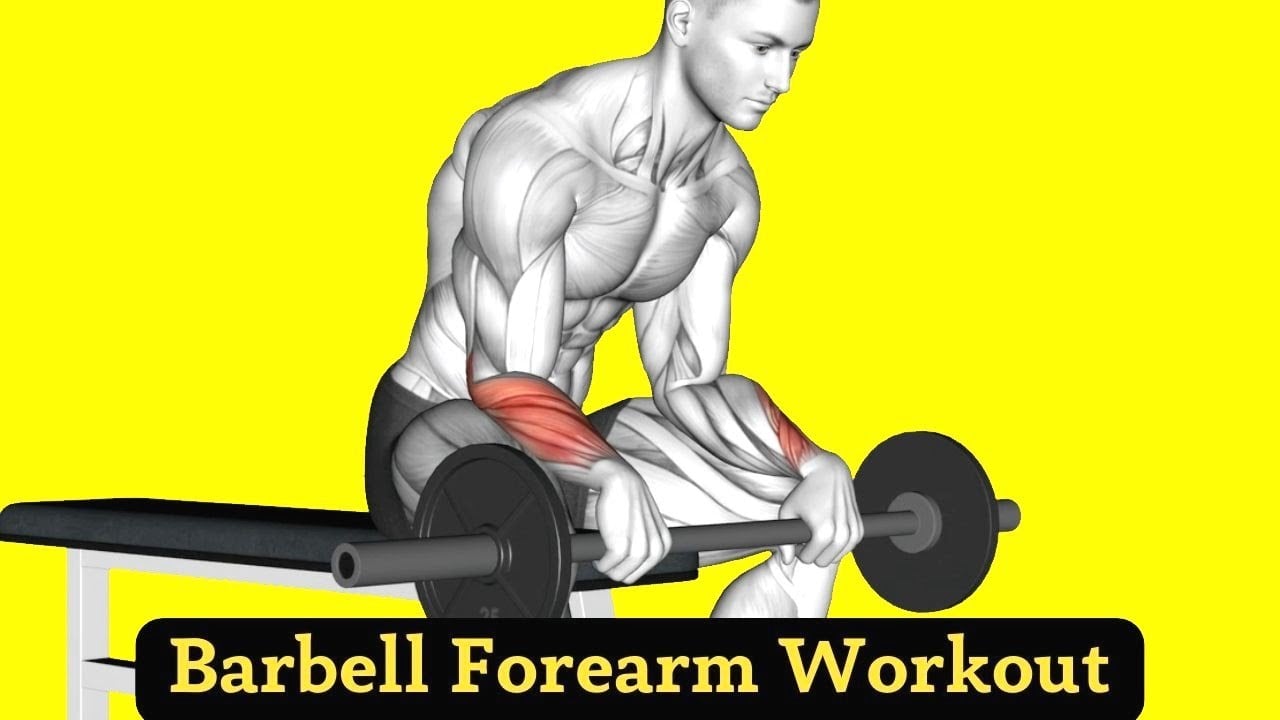Athletes, weightlifters, and anyone who wants to strengthen their grip and forearm size will benefit from training forearms with barbells.
Strong forearms aren’t just about looks; they’re crucial for a solid grip, which translates to better performance in various sports and activities.
They help you lift heavier weights and improve your performance in various sports and activities, such as rock climbing, golf swings, racket sports, and many others.
A study published found a significant correlation between stronger forearms and performance in exercises such as deadlifts and bench presses.
Let’s explore the 10 best barbell exercises and useful tips for a training program to maximize your forearm gains.

- 10 Barbell Exercises For Forearms
- 1. Barbell Wrist Curl
- 2. Barbell Reverse Wrist Curl
- 3. Barbell Finger Rolls
- 4. Barbell Reverse Curl
- 5. EZ Bar Reverse Grip Preacher Curl
- 6. Behind-The-Back Barbell Curl
- 7. Barbell Drag Curl
- 8. Overhead Barbell Carry
- 9. Fat Grip Barbell Curl
- 10. Barbell Holds
- Build Bigger Forearm With Barbell Workout
- 1. Sets For Forearm
- 2. Repetitions (Reps) For Forearm
- 3. Frequency Of Forearm Workout
- 4. Beginner Forearm Workout Plan
- 5. Intermediate Forearm Workout Plan
- Forearm Muscles
- Flexor Muscles
- Extensor Muscles
- Pronator and Supinator Muscles
- Brachioradialis
- References
10 Barbell Exercises For Forearms
These are the best 10 barbell exercises to build forearm size and grip strength.
1. Barbell Wrist Curl
Barbell wrist curls target the forearm muscles, specifically the wrist flexors. They are a great exercise for improving grip strength and forearm size and definition.
According to the study, a 12-week periodized forearm training program can enhance wrist and forearm strength and bat-end velocity in baseball players.
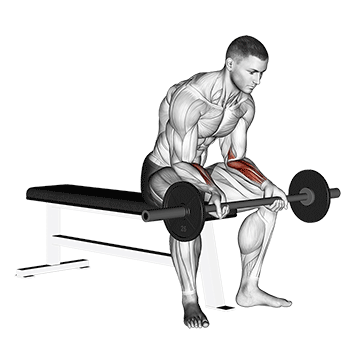
How To Do
- Grasp the barbell with an underhand grip (palm facing up).
- Rest your forearms on the bench/quad.
- Keep your forearms flat on the bench/quad and slowly curl the barbell by flexing your wrists.
- Hold at top contraction and then slowly lower the barbell back to the starting position.
2. Barbell Reverse Wrist Curl
Barbell Reverse wrist curls are similar to regular wrist curls but with a reversed hand position. It primarily targets the forearm muscles, particularly the brachioradialis and wrist extensors.
Strong extensor muscles contribute to better grip stability and control. This can benefit activities requiring a firm grip, such as weightlifting, racket sports, and manual labor.
Other ways to improve forearm size and strength with a reverse wrist curl are:
- Reverse Dumbbell Wrist Curl
- Cable Reverse Wrist Curl
- Single Arm Reverse Wrist Curl
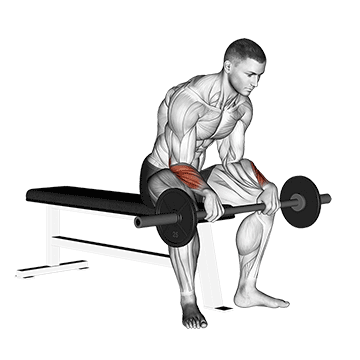
How To Do
- Hold a barbell with an overhand grip (palms facing down). Your hands should be slightly wider than shoulder-width apart.
- Lift the weight as high as possible by extending your wrists fully.
- Hold the contracted position briefly at the top, then slowly lower the weight back to the starting position by straightening your wrists.
- Perform the desired repetitions, usually 10–15 reps per set.
- Avoid using momentum to lift the weight and focus on contracting your forearm muscles.
3. Barbell Finger Rolls
The barbell finger roll specifically targets the muscles responsible for finger flexion. It is particularly effective for strengthening the fingers and grip strength.
A solid grip and strong fingers are beneficial for grasping, holding, or manipulating objects, such as weightlifting, rock climbing, and everyday tasks.
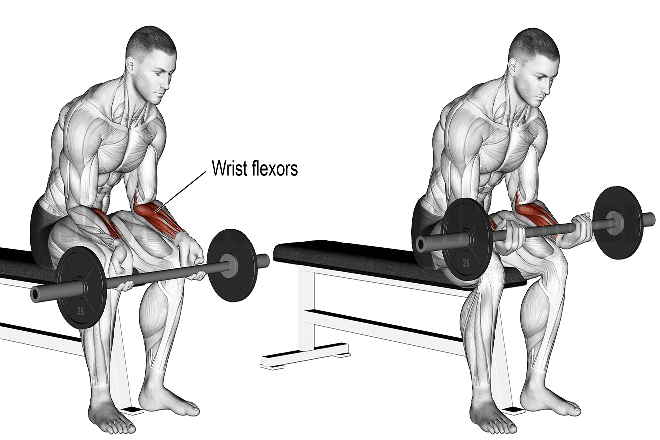
How To Do
- Sit on a bench or chair with your back straight and feet flat on the floor.
- Hold a barbell with palms facing up.
- Lower the barbell as far as possible by extending your fingers, allowing them to roll down your hands.
- Catch the barbell with the final joint in your fingers.
- Curl the barbell up as high as possible by closing your hands and flexing your fingers.
- Exhale as you curl the barbell up and hold the contraction at the top.
- Slowly lower the barbell back to the starting position, extending your fingers and allowing the barbell to roll down your hands.
4. Barbell Reverse Curl
The barbell reverse curl is a non-negotiable component of a barbell arm workout that primarily targets the brachioradialis and brachialis muscles.
This helps make your wrists stronger and more flexible, which helps you turn and control things with your hands and wrists.
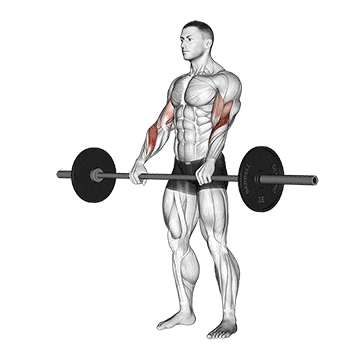
How To Do
- Grab the bar with a shoulder-width grip with your hands on top of the bar (pronated grip)
- Curl the bar up to shoulder level by bending your elbows.
- Your body should remain fixed. Only your biceps should be used to move the weight.
- Lower the bar back down to the arms’ extended position.
5. EZ Bar Reverse Grip Preacher Curl
The reverse preacher curl is a variation of the standard preacher curl targeting your brachialis muscle, which lies deeper than your biceps brachii in the upper arm and brachioradialis lower forearm muscles.
The brachialis and brachioradialis muscles help the elbows flex, while the wrist flexors act as stabilizer muscles and contract.
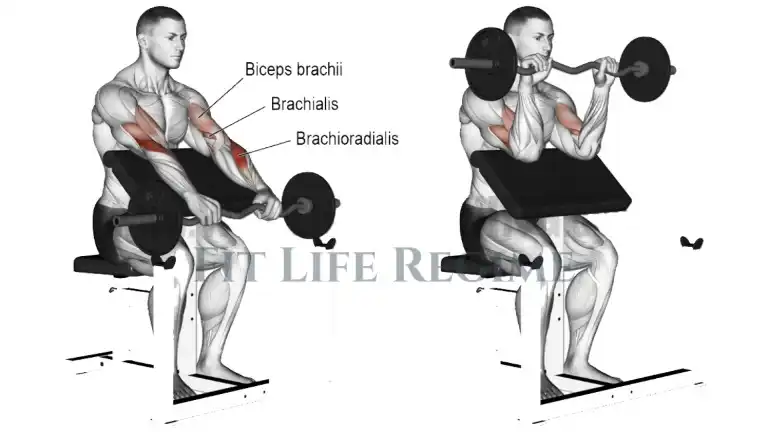
How To Do
- Set the seat so the backs of your upper arms rest comfortably on the pad.
- Grab the EZ bar with a pronated grip (palms facing down).
- Contract your forearms to curl the bar up until your forearms are nearly perpendicular (90 degrees) to the floor.
- Slowly lower the weight back to the starting position.
- Make sure that you perform the movement slowly with controlled repetition timing.
6. Behind-The-Back Barbell Curl
Behind-the-back barbell curls are a variation of forearm curls that primarily focus on strengthening the muscles of the fingers and forearms. They increase the range of motion and emphasize finger flexion.
Grip Strength is directly related to forearm and wrist strength. A strong grasp is essential for numerous sports, work-related tasks, and activities that require a firm hold.
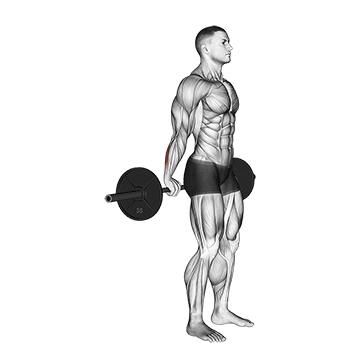
How To Do It
- Stand with your feet shoulder-width apart and hold a barbell behind your back, with your palms facing backward.
- Let your arms naturally hang down, with the barbell behind your hips.
- Keeping your arms still, curl your fingers and squeeze, flexing your fingers as much as you can.
- Hold the contracted position for a moment, then slowly release and extend your fingers to return to the starting position.
- Repeat for the desired number of repetitions.
7. Barbell Drag Curl
The barbell drag curl is an extremely effective forearm and bicep exercise, although it is less popular than the standard barbell curl exercises.
If you want to improve your arm size, strength, and appearance, the drag curl is for you.

How To Do
- Stand with your feet shoulder-width apart, your knees slightly bent, and your abs are drawn in.
- Grab the barbell with a double underhand (supinated) grip with your hands slightly wider than shoulder-width apart.
- Bring your elbows and shoulders back slightly as you curl the barbell upwards. It should feel like you are “dragging” the barbell up to your body.
- Squeeze your biceps hard at the top and slowly return to the starting position.
- Perform this exercise in a slow, controlled manner for best results.
8. Overhead Barbell Carry
Overhead barbell carry is a highly effective and demanding exercise that primarily targets the forearms, shoulders, and core muscles.
It involves holding a barbell overhead while walking or moving, which requires a lot of strength, stability, and coordination.
If you’re new to overhead barbell carry or attempting heavier weights, it’s advisable to have a spotter nearby or perform the exercise within a safety rack for added security.
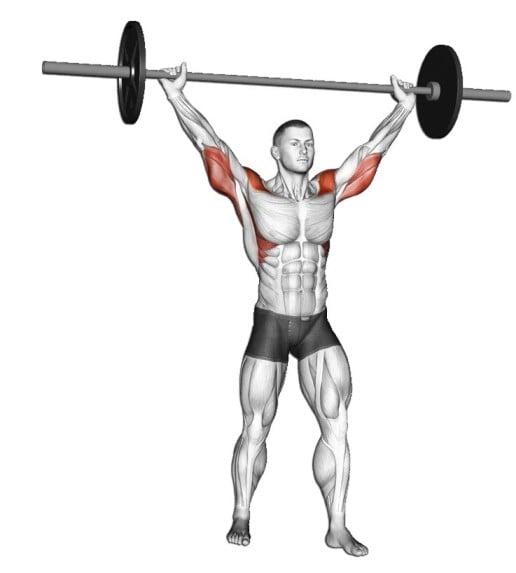
How To Do
- Set up a barbell with an appropriate weight on a squat rack or lifting platform.
- Lift the barbell from the rack and press it up high with extended arms.
- Maintain a tight core and stable shoulder position.
- Start by walking forward, taking small, controlled steps while keeping the barbell stable overhead.
- Walk for a predetermined distance or time while maintaining proper form and control.
9. Fat Grip Barbell Curl
The Fat Grip Barbell Curl is a variation of the traditional barbell curl exercise, where a thick grip attachment is added to the barbell.
This modification increases the diameter of the bar, which will challenge your grip strength and activate additional muscles in your forearms.
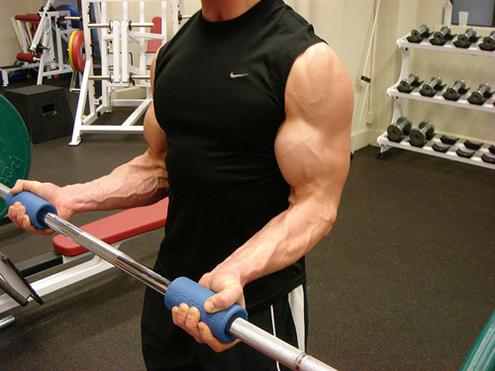
How To Do
- Attach the Fat Grip to a regular barbell. Make sure that it is securely tightened.
- Stand upright with a shoulder-width stance.
- Hold the barbell with an underhand grip (palms facing up) and hands shoulder-width apart.
- Keep your elbows close to your sides and fully extend your arms.
- Exhale, and slowly curl the barbell towards your shoulders.
- Hold for a moment and squeeze your biceps at the top.
- Then, slowly lower the barbell back to the starting position.
10. Barbell Holds
During Barbell holds, you must grip and hold a loaded barbell for a specified duration without any additional movement.
During the hold, the forearm muscles, including the flexors and extensors, are contracted for a long time, which makes them grow bigger and stronger.
A study has also shown that stronger forearms can prevent common injuries, such as tennis elbow (lateral epicondylitis) and other overuse injuries.
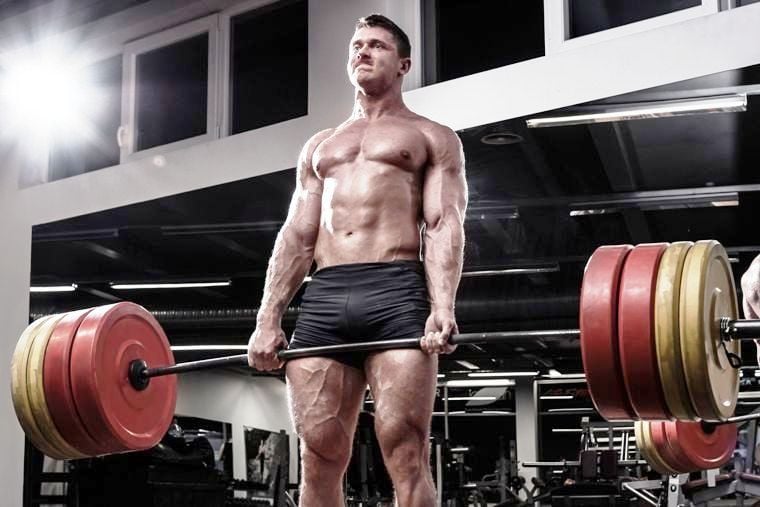
How To Do
- Select a weight that is suitable for your present level of physical strength.
- Stand tall with your feet shoulder-width apart and a slight bend in your knees.
- Grip the barbell with an overhand or mixed grip. Pick a tough weight that lets you stay in the position for the long time you want.
- Lift the barbell off the rack or from the ground with extended arms.
- Hold the barbell in a static position for the desired duration. Try to hold it for 20-60 seconds.
- Make sure your grip is firm and doesn’t slip during the hold.
- After completing the hold, lower the barbell back to the starting position.
Build Bigger Forearm With Barbell Workout
There are some general guidelines to help you get started.
1. Sets For Forearm
- Beginners: Start with 2-3 sets per exercise.
- Intermediate: Aim for 3-4 sets per exercise.
- Advanced: Perform 4-5 sets per exercise.
2. Repetitions (Reps) For Forearm
- Strength and Power: Focus on lower reps (around 6-8) with heavier weights to challenge the muscles and promote strength gains.
- Hypertrophy (Muscle Growth): Aim for moderate reps (around 8-12) with weights that fatigue the muscles within the desired rep range.
- Endurance: Perform higher reps (around 12-15 or more) with lighter weights to build muscular endurance.
3. Frequency Of Forearm Workout
- Beginners: Start with 1-2 forearm workouts per week, allowing ample recovery time between sessions.
- Intermediate: Aim for 2-3 weekly workouts, with at least two days of rest in between.
- Advanced: Perform 3-4 workouts per week, incorporating various exercises and intensity levels.
4. Beginner Forearm Workout Plan
| Exercise | Reps | Sets |
|---|---|---|
| Barbell Wrist Curls | 10-12 | 3 |
| Barbell Reverse Wrist Curls | 10-12 | 3 |
| Barbell Drag Curl | 8-10 | 3 |
5. Intermediate Forearm Workout Plan
| Exercise | Reps | Sets |
|---|---|---|
| Behind-the-Back Wrist Curls | 8-10 | 4 |
| Reverse Barbell Wrist Curls | 8-10 | 4 |
| Barbell Reverse Grip Curl | 10-12 | 3 |
Forearm Muscles
The forearm is a complex area of the upper limb that contains numerous muscles responsible for various movements and functions.
To effectively target the forearm, it is essential to understand the forearm muscles.
Let’s delve into the key muscles of the forearm:
Flexor Muscles
- Flexor Digitorum Profundus: This muscle runs along the forearm and flexes the fingers.
- Flexor Digitorum Superficialis: Positioned above the flexor digitorum profundus, this muscle also flexes the fingers.
- Flexor Carpi Radialis: Located on the inner side of the forearm, this muscle flexes and abducts the wrist.
- Palmaris Longus: this muscle aids wrist flexion and tenses the palmar aponeurosis.
Extensor Muscles
- Extensor Digitorum: Positioned on the back of the forearm, this muscle extends the fingers.
- Extensor Carpi Ulnaris: Located on the outer side of the forearm, this muscle extends and adducts the wrist.
- Extensor Carpi Radialis Longus and Brevis: These muscles extend and abduct the wrist.
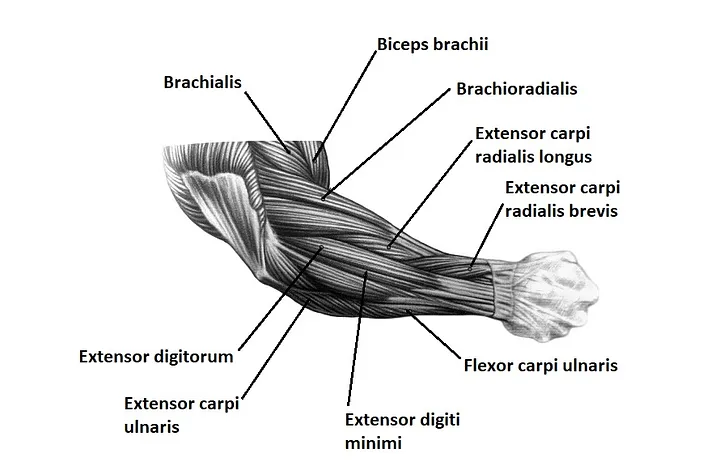
Pronator and Supinator Muscles
- Pronator Teres: Positioned on the inner side of the forearm, this muscle pronates the forearm (rotates it to face downward).
- Pronator Quadratus: Located near the wrist, this muscle assists in pronation.
- Supinator: Situated on the outer side of the forearm, this muscle supinates the forearm (rotates it to face upward).
Brachioradialis
Brachioradialis is one of the muscles comprising the forearm’s posterior compartment. It is the most superficial muscle of the radial side of the forearm.
Training the Brachioradialis is essential for building bigger forearms and producing powerful pulling movements like chin-ups and rows.
References
- Mathiowetz, V., et al. (2004). Grip and Pinch Strength: Norms for 6- to 19-Year-Olds. The American Journal of Occupational Therapy, 58(2), 97-104.
- Stasinopoulos, D., & Johnson, M. I. (2007). Cyriax Physiotherapy for Tennis Elbow/Lateral Epicondylitis. British Journal of Sports Medicine, 41(11), 639-642.
- Mark D Peterson. et al. Low Normalized Grip Strength is a Biomarker for Cardiometabolic Disease and Physical Disabilities Among U.S. and Chinese Adults. Multicenter Study J Gerontol A Biol Sci Med Sci2017 Oct 12;72(11):1525-1531. doi: 10.1093/gerona/glx031.

Manish is a NASM-certified fitness and nutrition coach with over 10 years of experience in weight lifting and fat loss fitness coaching. He specializes in gym-based training and has a lot of knowledge about exercise, lifting technique, biomechanics, and more.
Through “Fit Life Regime,” he generously shares the insights he’s gained over a decade in the field. His goal is to equip others with the knowledge to start their own fitness journey.

